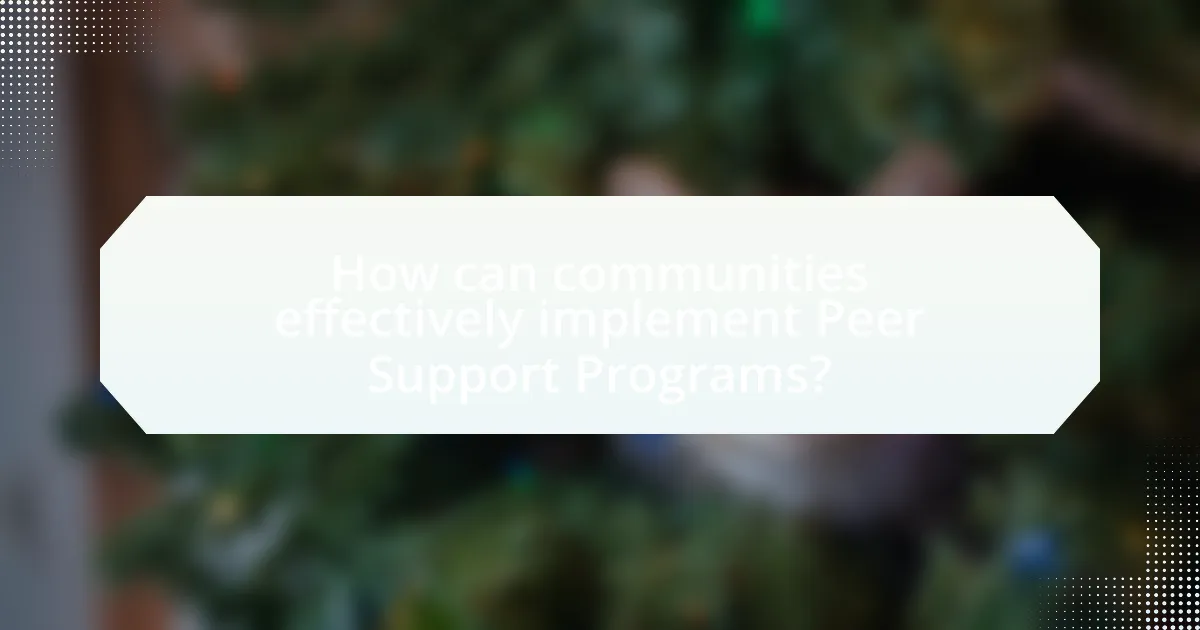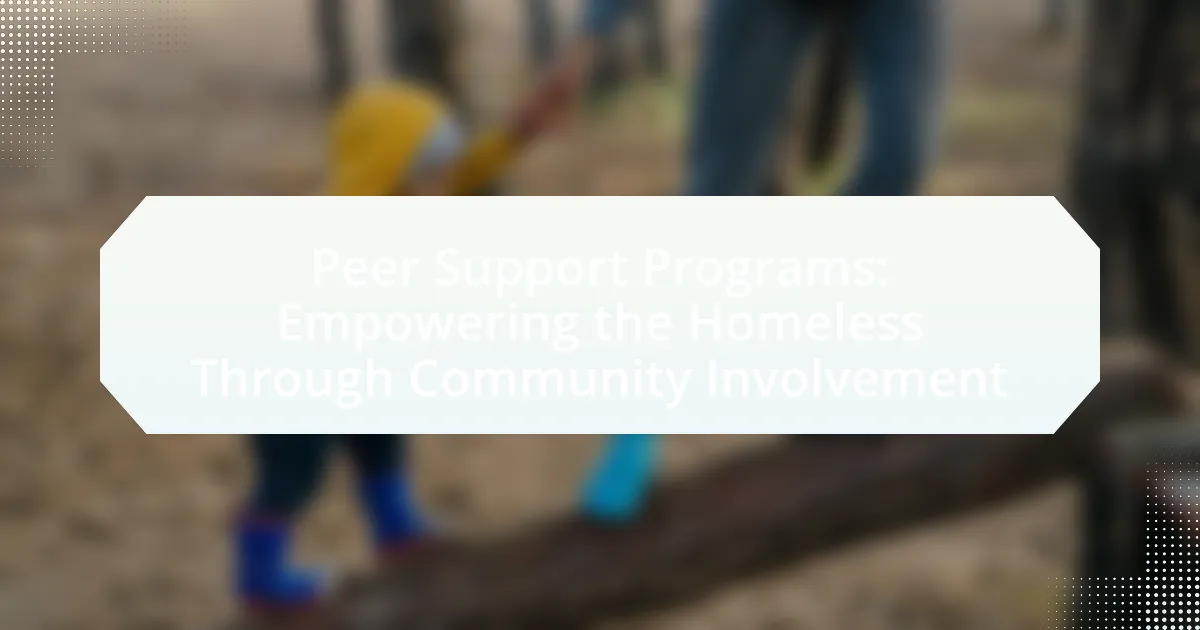Peer Support Programs are structured initiatives designed to connect individuals experiencing homelessness with peers who have successfully navigated similar challenges. These programs provide emotional support, practical assistance, and guidance, fostering community and belonging among participants. Research shows that peer support significantly improves mental health outcomes, increases self-efficacy, and enhances access to resources, ultimately contributing to stable housing and reduced feelings of isolation. The article explores the functioning of these programs within communities, the roles of peer supporters, training and selection processes, and the importance of community involvement and collaboration for effective implementation. Additionally, it addresses challenges faced by these programs and highlights the long-term benefits they offer in reducing homelessness.

What are Peer Support Programs for the Homeless?
Peer Support Programs for the homeless are structured initiatives that connect individuals experiencing homelessness with peers who have lived experience in overcoming similar challenges. These programs aim to provide emotional support, practical assistance, and guidance, fostering a sense of community and belonging among participants. Research indicates that peer support can significantly improve mental health outcomes and increase the likelihood of securing stable housing, as evidenced by studies showing that participants in peer support programs report higher levels of hope and motivation compared to those who do not engage in such programs.
How do Peer Support Programs function within communities?
Peer Support Programs function within communities by facilitating connections among individuals who share similar experiences, particularly in addressing issues like homelessness. These programs create a supportive environment where participants can share their challenges and successes, fostering a sense of belonging and empowerment. Research indicates that peer support can lead to improved mental health outcomes, as evidenced by a study published in the Journal of Community Psychology, which found that participants in peer support programs reported higher levels of self-efficacy and lower levels of depression. By leveraging lived experiences, these programs enhance community resilience and promote recovery, ultimately contributing to the well-being of vulnerable populations.
What roles do peer supporters play in these programs?
Peer supporters in these programs serve as mentors, advocates, and facilitators for individuals experiencing homelessness. They provide emotional support, share lived experiences, and help navigate resources, fostering a sense of community and belonging. Research indicates that peer support can significantly improve mental health outcomes and increase engagement with services, as evidenced by studies showing that individuals who receive peer support report higher levels of satisfaction and lower levels of distress.
How are peer supporters trained and selected?
Peer supporters are selected based on their lived experiences and ability to connect with individuals facing similar challenges. The selection process typically involves interviews and assessments to evaluate their empathy, communication skills, and commitment to helping others. Training for peer supporters includes workshops and courses that cover topics such as active listening, crisis intervention, and resource navigation, ensuring they are equipped to provide effective support. Research indicates that programs that incorporate both rigorous selection and comprehensive training yield better outcomes for both peer supporters and those they assist, enhancing the overall effectiveness of peer support initiatives.
Why are Peer Support Programs important for the homeless?
Peer Support Programs are important for the homeless because they provide essential emotional support and practical assistance from individuals who have experienced homelessness themselves. These programs foster a sense of community and belonging, which is crucial for individuals facing social isolation. Research indicates that peer support can lead to improved mental health outcomes, increased self-efficacy, and better access to resources, as participants often share valuable insights and coping strategies based on their lived experiences. For instance, a study published in the American Journal of Public Health found that peer support interventions significantly reduced feelings of loneliness and increased participants’ engagement with social services.
What impact do these programs have on mental health?
Peer support programs significantly improve mental health among participants. These programs foster a sense of belonging and community, which can reduce feelings of isolation and depression commonly experienced by homeless individuals. Research indicates that peer support can lead to increased self-esteem and empowerment, as participants engage in shared experiences and mutual support. A study published in the Journal of Community Psychology found that individuals involved in peer support programs reported lower levels of anxiety and depression, highlighting the positive psychological effects of community involvement.
How do they foster a sense of belonging and community?
Peer support programs foster a sense of belonging and community by creating inclusive environments where individuals experiencing homelessness can connect with others who share similar challenges. These programs facilitate regular group meetings and activities that encourage social interaction, mutual support, and the sharing of personal experiences, which helps to build trust and camaraderie among participants. Research indicates that such interactions can significantly reduce feelings of isolation and promote a sense of identity within the community, as evidenced by studies showing that participants in peer support initiatives report higher levels of social connectedness and emotional well-being.

What are the key components of successful Peer Support Programs?
Successful Peer Support Programs are built on key components such as trained peer supporters, a structured framework, and ongoing evaluation. Trained peer supporters, who have lived experience, provide relatable guidance and foster trust among participants. A structured framework ensures that the program has clear goals, defined roles, and established processes, which enhances effectiveness and consistency. Ongoing evaluation allows for the assessment of program impact and participant satisfaction, enabling continuous improvement. Research indicates that programs with these components demonstrate higher engagement and better outcomes for participants, as evidenced by studies showing improved mental health and social integration among individuals involved in peer support initiatives.
How do community involvement and collaboration enhance these programs?
Community involvement and collaboration significantly enhance peer support programs for the homeless by fostering trust and resource sharing. When community members actively participate, they contribute local knowledge and networks that can lead to more effective support services tailored to the specific needs of the homeless population. For instance, studies show that programs with strong community ties report higher engagement rates and better outcomes, as they leverage local resources such as shelters, food banks, and healthcare services. This collaborative approach not only increases the availability of essential services but also builds a sense of belonging and empowerment among participants, which is crucial for long-term success in addressing homelessness.
What partnerships are essential for effective program implementation?
Effective program implementation for peer support programs targeting the homeless requires partnerships with local government agencies, non-profit organizations, healthcare providers, and community stakeholders. Local government agencies can provide essential resources and policy support, while non-profit organizations often have established networks and expertise in outreach and service delivery. Healthcare providers are crucial for addressing the physical and mental health needs of the homeless population, ensuring comprehensive care. Community stakeholders, including businesses and residents, can foster a supportive environment and enhance program visibility. These partnerships are validated by successful case studies, such as the collaboration between the Los Angeles Homeless Services Authority and various non-profits, which has led to improved service delivery and outcomes for homeless individuals.
How can local organizations contribute to the success of these programs?
Local organizations can significantly contribute to the success of peer support programs for the homeless by providing resources, expertise, and community connections. These organizations often have established networks that facilitate outreach and engagement with homeless individuals, ensuring that programs reach those in need. For instance, local nonprofits can offer training for peer supporters, enhancing their skills and effectiveness in providing assistance. Additionally, collaboration with local businesses can lead to job placement opportunities for program participants, which is crucial for long-term success. Research indicates that community involvement increases program effectiveness; a study by the National Alliance to End Homelessness found that programs with strong local partnerships have higher success rates in reducing homelessness.
What challenges do Peer Support Programs face?
Peer Support Programs face several challenges, including funding limitations, participant engagement, and training requirements. Funding limitations often hinder the sustainability and expansion of these programs, as many rely on grants or donations that can be inconsistent. Participant engagement can be difficult due to the transient nature of homelessness, making it hard to maintain a consistent peer support network. Additionally, training requirements for peer supporters can be extensive, necessitating resources and time that may not be readily available. These challenges can significantly impact the effectiveness and reach of Peer Support Programs aimed at empowering the homeless community.
How can funding issues affect program sustainability?
Funding issues can significantly undermine program sustainability by limiting resources necessary for ongoing operations and support. When financial backing is inconsistent or insufficient, programs may struggle to maintain staff, provide essential services, or invest in necessary infrastructure. For instance, a study by the National Alliance to End Homelessness found that programs with stable funding are 50% more likely to achieve long-term success in supporting homeless individuals compared to those facing funding instability. This correlation highlights that without reliable funding, peer support programs aimed at empowering the homeless may face disruptions that jeopardize their effectiveness and longevity.
What barriers do peer supporters encounter in their roles?
Peer supporters encounter several barriers in their roles, including lack of training, emotional burnout, and insufficient organizational support. Lack of training can hinder their ability to effectively assist peers, as they may not possess the necessary skills or knowledge to address complex issues. Emotional burnout arises from the high demands of supporting others, which can lead to decreased effectiveness and personal distress. Insufficient organizational support, such as inadequate resources or supervision, can further complicate their ability to provide consistent and effective assistance. These barriers can significantly impact the overall success of peer support programs aimed at empowering the homeless.

How can communities effectively implement Peer Support Programs?
Communities can effectively implement Peer Support Programs by establishing structured training for peer supporters, ensuring they possess the necessary skills and knowledge to assist others. This training should include mental health first aid, active listening techniques, and crisis intervention strategies, which have been shown to enhance the effectiveness of peer support initiatives. Furthermore, communities should create a supportive environment that fosters trust and openness, allowing individuals to share their experiences without fear of judgment. Research indicates that programs with strong community backing and clear communication channels between peers and professionals yield better outcomes, as seen in the “Peer Support in Mental Health: A Review of the Evidence” by Repper and Carter, which highlights the positive impact of peer support on recovery and social inclusion.
What best practices should be followed when establishing these programs?
When establishing peer support programs for the homeless, best practices include involving individuals with lived experience in the program design and implementation. This approach ensures that the programs are relevant and effective, as those who have faced homelessness can provide valuable insights into the challenges and needs of their peers. Research indicates that programs designed with input from participants have higher engagement and success rates, as seen in studies like “Peer Support in Homeless Services” by the National Alliance to End Homelessness, which highlights the importance of peer involvement in fostering trust and relatability. Additionally, providing comprehensive training for peer supporters enhances their effectiveness, equipping them with the skills necessary to offer meaningful support.
How can communities assess the needs of their homeless population?
Communities can assess the needs of their homeless population through comprehensive surveys and direct outreach initiatives. These methods allow for the collection of data regarding the specific challenges faced by individuals experiencing homelessness, such as access to healthcare, employment opportunities, and housing stability. For instance, the U.S. Department of Housing and Urban Development (HUD) recommends conducting point-in-time counts and needs assessments to gather accurate information about the demographics and needs of homeless individuals. This data can then inform targeted interventions and resource allocation, ensuring that support services are effectively tailored to meet the unique needs of the homeless population.
What strategies can be employed to recruit and retain peer supporters?
To recruit and retain peer supporters, organizations can implement targeted outreach, provide comprehensive training, and foster a supportive community environment. Targeted outreach involves identifying individuals with lived experiences relevant to the peer support role, which can enhance relatability and trust. Comprehensive training equips peer supporters with essential skills, ensuring they feel competent and confident in their roles. Fostering a supportive community environment encourages ongoing engagement and connection among peer supporters, which is crucial for retention. Research indicates that peer support programs with strong community ties and adequate training have higher retention rates, as seen in studies conducted by the Substance Abuse and Mental Health Services Administration, which highlight the importance of these strategies in effective peer support initiatives.
What resources are available for communities looking to start Peer Support Programs?
Communities looking to start Peer Support Programs can access various resources, including training materials, funding opportunities, and established program models. Organizations such as the Substance Abuse and Mental Health Services Administration (SAMHSA) provide comprehensive toolkits and guidelines for implementing peer support initiatives. Additionally, local nonprofits and mental health organizations often offer workshops and training sessions to equip community members with the necessary skills. Research indicates that peer support can significantly improve mental health outcomes, as evidenced by a study published in the Journal of Mental Health, which found that peer support programs led to a 30% increase in participant well-being.
Where can communities find training materials and support networks?
Communities can find training materials and support networks through organizations such as the National Alliance on Mental Illness (NAMI) and the Substance Abuse and Mental Health Services Administration (SAMHSA). NAMI offers resources and training programs specifically designed for peer support, while SAMHSA provides a range of materials focused on mental health and substance use recovery. Additionally, local community centers and non-profit organizations often host workshops and training sessions that facilitate peer support initiatives, enhancing community involvement and empowerment for the homeless population.
What funding opportunities exist for Peer Support Programs?
Funding opportunities for Peer Support Programs include government grants, private foundations, and nonprofit organizations. For instance, the Substance Abuse and Mental Health Services Administration (SAMHSA) offers grants specifically aimed at enhancing peer support services. Additionally, the Robert Wood Johnson Foundation provides funding for initiatives that improve community health, which can encompass peer support programs. Furthermore, local and state governments often allocate funds for mental health and homelessness initiatives, which can be accessed by organizations implementing peer support strategies. These funding sources are critical for sustaining and expanding peer support services that empower individuals experiencing homelessness.
What are the long-term benefits of Peer Support Programs for the homeless?
Peer Support Programs for the homeless provide long-term benefits such as improved mental health, increased social connections, and enhanced self-sufficiency. These programs facilitate peer relationships that foster trust and understanding, which can lead to reduced feelings of isolation and depression among participants. Research indicates that individuals engaged in peer support report higher levels of life satisfaction and lower rates of substance abuse, as evidenced by a study published in the Journal of Community Psychology, which found that participants in peer support programs experienced a 30% decrease in depressive symptoms over a year. Additionally, these programs often lead to greater access to resources, enabling individuals to secure stable housing and employment, thereby promoting long-term stability and independence.
How do these programs contribute to reducing homelessness in the community?
Peer support programs contribute to reducing homelessness in the community by providing individuals with emotional support, practical assistance, and resources to navigate housing challenges. These programs facilitate connections between those experiencing homelessness and peers who have successfully transitioned to stable housing, fostering a sense of belonging and motivation. Research indicates that peer support can lead to improved mental health outcomes and increased housing stability, as evidenced by a study published in the American Journal of Public Health, which found that participants in peer support programs were 50% more likely to secure permanent housing compared to those who did not receive such support.
What success stories illustrate the effectiveness of Peer Support Programs?
Peer Support Programs have demonstrated effectiveness through various success stories, notably the “Pathways to Housing” initiative in New York City. This program employs peer specialists who have experienced homelessness themselves, leading to a 70% reduction in homelessness among participants. Additionally, the “Homeless Outreach Program” in Los Angeles reported that 85% of individuals engaged in peer support found stable housing within a year. These examples illustrate how peer support not only fosters community involvement but also significantly improves housing stability for the homeless population.

Leave a Reply